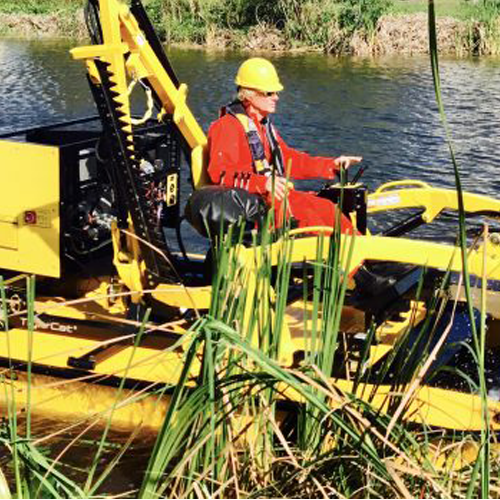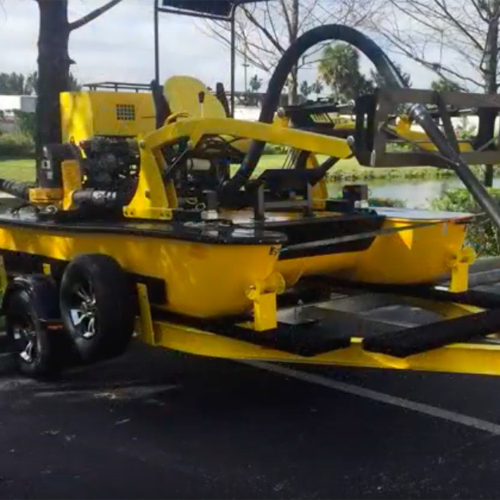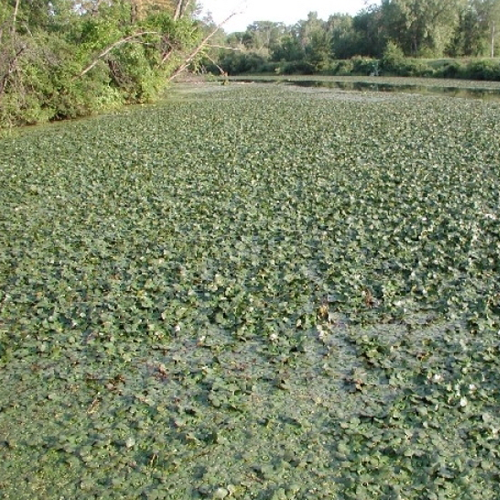Technology and Improved Efficacy of Mechanical Control of Hydrilla
A case study explaining the mechanical control of Hydrilla, its benefits, and efficiency.

Mechanical control of hydrilla has been hindered by the belief that the process provides only short-term control (a few weeks) due to rapid regrowth, has a high cost per acre harvest and excessive
fish bycatch. This was certainly the result reported by McGehee (1979) on a US Army Corps of Engineers harvesting project conducted on Orange Lake, FL in 1976 and 1977. The Corps study evaluated the Aquamarine “AQUA-TRIO” consisting of an H-650 harvester, transporter and shore conveyer on hydrilla control in navigation trails and fishing areas in the lake. The harvester could cut hydrilla to a depth of 5 feet and was operating in surface-matted hydrilla weighing an estimated 22,000 lbs/acre fresh weight. Thee average hydrilla load on the harvester weighed 2,900 lbs which by calculation (22,000 lbs/acre divided by 2,900 lbs/load) indicates it took 7.6 loads to harvest 1 acre of hydrilla. The highest number of loads in an 8 hour day was 33, so the H-650 in this test harvested a maximum of 4.3 acres per day. The operation maintained 163 acres of hydrilla control over the 4 month period ( July – October 1977) at a total cost of $455/acre. It was also interesting that some areas of the lake had to be harvested 6 times (once every 15 days) while other areas only had to be harvested once to maintain open boating trails.
The development of fluridone-resistant hydrilla populations in the late 1990s on several large lakes in Florida prompted managers and scientists to develop new aquatic herbicides, increase efforts to find suitable biological control agents, and re-evaluate use patterns of traditional herbicides and mechanical harvesting.
Reviewing the Orange Lake study (conducted 35 years ago) raises several questions primarily involving increased harvesting efficiency, longevity of control and reduced fish bycatch.
Harvesting efficiency can be in-creased by keeping the harvester operating as long as possible before requiring transport and unloading of harvested vegetation. It was reported by Sabol (1987) that in-lake disposal of hydrilla reduced harvester down time by 50%. Thee 1977 H-650 harvester tests on Orange Lake showed that it took 7.6 loads to harvest an acre of surface-matted hydrilla. Thee use of large capacity harvesters such as the 70-foot Kelpin harvester showed it could harvest 1 acre of surface-matted hydrilla in approximately 1 hour (Haller 1996). Assuming transport and o$-loading times similar to the H-650, the larger Kelpin harvester can theoretically harvest 7 – 8 acres in an 8 hour day, nearly doubling the harvesting efficiency of the H-650. Another option to increase harvesting time would be to harvest when less hydrilla biomass is present to decrease transport/unloading time.
Harvest longevity is the amount of time that a harvested area remains weed-free or usable following a single harvest. The Orange Lake study reported that some areas of the lake required 6 harvests and other areas only required 1 harvest. If hydrilla grows an inch/day, as often reported, harvesting to a water depth of 10 feet would provide 4 months of control compared to harvesting to a depth of 5 feet which would provide 2 months of control. Engle (1990) reported reduced regrowth rates of pondweeds harvested in early summer compared to plots harvested in late summer. The longevity of hydrilla control can be increased by harvesting to greater water depths, but until recently, hydrilla plants needed to be visible in order to be harvested.
Reducing fish bycatch according to Engel (1990) depends upon the number and size of fish present, in-shore or off-shore location of the harvesting site, and the density of the cut vegetation. The fish bycatch in the Orange Lake study (Haller 1980) was a worst case scenario. Surface-matted hydrilla with maximum vegetation density had high numbers of juvenile sunfish harvested (hatched in Spring 1977) and contained 3 species that are more typical of dense in-shore littoral habitats (bluefin killifish, spotted sunfish and gambusia). We now believe that limnological factors also contributed to the high bycatch in Orange Lake. Hydrilla was harvested and fish were counted from transects harvested in the morning during late August 1977.
This surface-matted hydrilla, growing in 5 – 7 feet of water over a highly organic lake bottom probably contained oxygen in only the top 1 –2 feet of water. This lack of oxygenated water below the hydrilla mat likely concentrated the fish in the area of highest oxygen and highest hydrilla density which contributed significantly to increased fish bycatch.
The University of Florida-IFAS Center for Aquatic and Invasive Plants (CAIP) obtained funding from Osceola County, Florida through the US EPA Demonstration Project on Hydrilla and Hygrophila in the Upper Kissimmee Chain of Lakes (EPA Grant Number X796433105) to conduct a deep water harvesting operation in February and March 2012. A Kelpin 70-foot harvester was equipped to harvest hydrilla to water depths of 10 feet. The specific objectives of the project were to harvest hydrilla in a 100 acre area in Lake Tohopekaliga (Lake Toho) where the hydrilla was 3 – 6 feet tall in 8 – 10 feet of water, measure fish bycatch, and determine if any significant changes in water quality were caused by the harvesting operation. Hydrilla could not be seen from the water surface, so the harvester was equipped with GPS equipment to allow the operator to see previous harvest tracks and adjust the harvester to cut adjacent to those tracks. Fish bycatch was determined from 4 transects harvested across the 100 acre plot. The weight of the hydrilla in the 4 transects varied from 980 to 1,470 lbs fresh weight per acre, compared to the 22,000 lbs/acre in the 1977 Orange Lake study. The study was conducted in February 2012, prior to peak spawning of Lepomis and other species, so fewer juvenile fish were present. Water in the harvest site was deeper and well-oxygenated from the surface to the lake bottom which allowed greater vertical and horizontal opportunity for fish to escape. The hydrilla density was much lower and there was no hydrilla at the water surface. This avoided bycatch of common littoral species such as bluefin killifish, spotted sunfish and gambusia.
The total number of fish harvested in the deep water plot on Lake Toho was 121 ± 6 fish/acre compared to 27,000 ± 800 fish/acre in the 1977 Orange Lake study. Thee weight of fish harvested in the Lake Toho study was similarly very small compared to the weights harvested from Orange Lake in 1977.
Since the weight of the hydrilla in the Lake Toho study was minimal, the harvester was able to harvest at a rate of 2.0 to 2.4 acres/hour with no time required for transport and unloading during that period. Results of water quality studies before, during and after harvesting operations showed only temporary (a few hours) increased turbidity and no long-term impacts, probably as a result of operating in deep water with no disturbance of the lake bottom by paddle wheels used for propulsion.
This study clearly shows the feasibility of harvesting hydrilla in deep water before it reaches the water surface. Harvesting efficiency is greatly improved by handling 1,000 lbs/acre of hydrilla rather than 22,000 lbs/acre. This was made possible by the development of GPS and related software in the past few years, as well as the greater capacity of the larger harvesting equipment. Harvesting longevity is still being evaluated. However, 5 months following the Feb/ March 2012 harvesting operation, the 100 acre plot remains usable with approximately 25% of the water column infested. Fish bycatch in the Lake Toho study was < 1% of the bycatch found in the surface-matted hydrilla in Orange Lake during the 1977 study. The timing of the harvest, the depth of the water, and the height of the hydrilla below the surface likely contributed to the much lower and acceptable fish impacts.
Certainly additional improvements can be made to improve efficacy, but this study should dispel the dogma that mechanical harvesting of hydrilla is too expensive and too damaging to fish populations. For a complete list of references, please contact Dr. William Haller, University of Florida-IFAS Center for Aquatic & Invasive Plants, Gainesville, 352-392-9615, whaller@ufl.edu



